#Optimize AWS Lambda
Explore tagged Tumblr posts
Text
Explore the best practices for using AWS Lambda, including where to use it, security implications, performance optimization, and cost management tips. Learn how to leverage serverless computing effectively for scalable and secure applications.
0 notes
Text
Performance Best Practices Using Java and AWS Lambda: Combinations
Subscribe .tb0e30274-9552-4f02-8737-61d4b7a7ad49 { color: #fff; background: #222; border: 1px solid transparent; border-radius: undefinedpx; padding: 8px 21px; } .tb0e30274-9552-4f02-8737-61d4b7a7ad49.place-top { margin-top: -10px; } .tb0e30274-9552-4f02-8737-61d4b7a7ad49.place-top::before { content: “”; background-color: inherit; position: absolute; z-index: 2; width: 20px; height: 12px; }…

View On WordPress
#aws-lambda#aws-sdk#cloud-computing#java#java-best-practices#java-optimization#performance-testing#software-engineering
0 notes
Text
How Python Powers Scalable and Cost-Effective Cloud Solutions

Explore the role of Python in developing scalable and cost-effective cloud solutions. This guide covers Python's advantages in cloud computing, addresses potential challenges, and highlights real-world applications, providing insights into leveraging Python for efficient cloud development.
Introduction
In today's rapidly evolving digital landscape, businesses are increasingly leveraging cloud computing to enhance scalability, optimize costs, and drive innovation. Among the myriad of programming languages available, Python has emerged as a preferred choice for developing robust cloud solutions. Its simplicity, versatility, and extensive library support make it an ideal candidate for cloud-based applications.
In this comprehensive guide, we will delve into how Python empowers scalable and cost-effective cloud solutions, explore its advantages, address potential challenges, and highlight real-world applications.
Why Python is the Preferred Choice for Cloud Computing?
Python's popularity in cloud computing is driven by several factors, making it the preferred language for developing and managing cloud solutions. Here are some key reasons why Python stands out:
Simplicity and Readability: Python's clean and straightforward syntax allows developers to write and maintain code efficiently, reducing development time and costs.
Extensive Library Support: Python offers a rich set of libraries and frameworks like Django, Flask, and FastAPI for building cloud applications.
Seamless Integration with Cloud Services: Python is well-supported across major cloud platforms like AWS, Azure, and Google Cloud.
Automation and DevOps Friendly: Python supports infrastructure automation with tools like Ansible, Terraform, and Boto3.
Strong Community and Enterprise Adoption: Python has a massive global community that continuously improves and innovates cloud-related solutions.
How Python Enables Scalable Cloud Solutions?
Scalability is a critical factor in cloud computing, and Python provides multiple ways to achieve it:
1. Automation of Cloud Infrastructure
Python's compatibility with cloud service provider SDKs, such as AWS Boto3, Azure SDK for Python, and Google Cloud Client Library, enables developers to automate the provisioning and management of cloud resources efficiently.
2. Containerization and Orchestration
Python integrates seamlessly with Docker and Kubernetes, enabling businesses to deploy scalable containerized applications efficiently.
3. Cloud-Native Development
Frameworks like Flask, Django, and FastAPI support microservices architecture, allowing businesses to develop lightweight, scalable cloud applications.
4. Serverless Computing
Python's support for serverless platforms, including AWS Lambda, Azure Functions, and Google Cloud Functions, allows developers to build applications that automatically scale in response to demand, optimizing resource utilization and cost.
5. AI and Big Data Scalability
Python’s dominance in AI and data science makes it an ideal choice for cloud-based AI/ML services like AWS SageMaker, Google AI, and Azure Machine Learning.
Looking for expert Python developers to build scalable cloud solutions? Hire Python Developers now!
Advantages of Using Python for Cloud Computing
Cost Efficiency: Python’s compatibility with serverless computing and auto-scaling strategies minimizes cloud costs.
Faster Development: Python’s simplicity accelerates cloud application development, reducing time-to-market.
Cross-Platform Compatibility: Python runs seamlessly across different cloud platforms.
Security and Reliability: Python-based security tools help in encryption, authentication, and cloud monitoring.
Strong Community Support: Python developers worldwide contribute to continuous improvements, making it future-proof.
Challenges and Considerations
While Python offers many benefits, there are some challenges to consider:
Performance Limitations: Python is an interpreted language, which may not be as fast as compiled languages like Java or C++.
Memory Consumption: Python applications might require optimization to handle large-scale cloud workloads efficiently.
Learning Curve for Beginners: Though Python is simple, mastering cloud-specific frameworks requires time and expertise.
Python Libraries and Tools for Cloud Computing
Python’s ecosystem includes powerful libraries and tools tailored for cloud computing, such as:
Boto3: AWS SDK for Python, used for cloud automation.
Google Cloud Client Library: Helps interact with Google Cloud services.
Azure SDK for Python: Enables seamless integration with Microsoft Azure.
Apache Libcloud: Provides a unified interface for multiple cloud providers.
PyCaret: Simplifies machine learning deployment in cloud environments.
Real-World Applications of Python in Cloud Computing
1. Netflix - Scalable Streaming with Python
Netflix extensively uses Python for automation, data analysis, and managing cloud infrastructure, enabling seamless content delivery to millions of users.
2. Spotify - Cloud-Based Music Streaming
Spotify leverages Python for big data processing, recommendation algorithms, and cloud automation, ensuring high availability and scalability.
3. Reddit - Handling Massive Traffic
Reddit uses Python and AWS cloud solutions to manage heavy traffic while optimizing server costs efficiently.
Future of Python in Cloud Computing
The future of Python in cloud computing looks promising with emerging trends such as:
AI-Driven Cloud Automation: Python-powered AI and machine learning will drive intelligent cloud automation.
Edge Computing: Python will play a crucial role in processing data at the edge for IoT and real-time applications.
Hybrid and Multi-Cloud Strategies: Python’s flexibility will enable seamless integration across multiple cloud platforms.
Increased Adoption of Serverless Computing: More enterprises will adopt Python for cost-effective serverless applications.
Conclusion
Python's simplicity, versatility, and robust ecosystem make it a powerful tool for developing scalable and cost-effective cloud solutions. By leveraging Python's capabilities, businesses can enhance their cloud applications' performance, flexibility, and efficiency.
Ready to harness the power of Python for your cloud solutions? Explore our Python Development Services to discover how we can assist you in building scalable and efficient cloud applications.
FAQs
1. Why is Python used in cloud computing?
Python is widely used in cloud computing due to its simplicity, extensive libraries, and seamless integration with cloud platforms like AWS, Google Cloud, and Azure.
2. Is Python good for serverless computing?
Yes! Python works efficiently in serverless environments like AWS Lambda, Azure Functions, and Google Cloud Functions, making it an ideal choice for cost-effective, auto-scaling applications.
3. Which companies use Python for cloud solutions?
Major companies like Netflix, Spotify, Dropbox, and Reddit use Python for cloud automation, AI, and scalable infrastructure management.
4. How does Python help with cloud security?
Python offers robust security libraries like PyCryptodome and OpenSSL, enabling encryption, authentication, and cloud monitoring for secure cloud applications.
5. Can Python handle big data in the cloud?
Yes! Python supports big data processing with tools like Apache Spark, Pandas, and NumPy, making it suitable for data-driven cloud applications.
#Python development company#Python in Cloud Computing#Hire Python Developers#Python for Multi-Cloud Environments
2 notes
·
View notes
Text
The Future of Web Development: Trends, Techniques, and Tools
Web development is a dynamic field that is continually evolving to meet the demands of an increasingly digital world. With businesses relying more on online presence and user experience becoming a priority, web developers must stay abreast of the latest trends, technologies, and best practices. In this blog, we’ll delve into the current landscape of web development, explore emerging trends and tools, and discuss best practices to ensure successful web projects.
Understanding Web Development
Web development involves the creation and maintenance of websites and web applications. It encompasses a variety of tasks, including front-end development (what users see and interact with) and back-end development (the server-side that powers the application). A successful web project requires a blend of design, programming, and usability skills, with a focus on delivering a seamless user experience.
Key Trends in Web Development
Progressive Web Apps (PWAs): PWAs are web applications that provide a native app-like experience within the browser. They offer benefits like offline access, push notifications, and fast loading times. By leveraging modern web capabilities, PWAs enhance user engagement and can lead to higher conversion rates.
Single Page Applications (SPAs): SPAs load a single HTML page and dynamically update content as users interact with the app. This approach reduces page load times and provides a smoother experience. Frameworks like React, Angular, and Vue.js have made developing SPAs easier, allowing developers to create responsive and efficient applications.
Responsive Web Design: With the increasing use of mobile devices, responsive design has become essential. Websites must adapt to various screen sizes and orientations to ensure a consistent user experience. CSS frameworks like Bootstrap and Foundation help developers create fluid, responsive layouts quickly.
Voice Search Optimization: As voice-activated devices like Amazon Alexa and Google Home gain popularity, optimizing websites for voice search is crucial. This involves focusing on natural language processing and long-tail keywords, as users tend to speak in full sentences rather than typing short phrases.
Artificial Intelligence (AI) and Machine Learning: AI is transforming web development by enabling personalized user experiences and smarter applications. Chatbots, for instance, can provide instant customer support, while AI-driven analytics tools help developers understand user behavior and optimize websites accordingly.
Emerging Technologies in Web Development
JAMstack Architecture: JAMstack (JavaScript, APIs, Markup) is a modern web development architecture that decouples the front end from the back end. This approach enhances performance, security, and scalability by serving static content and fetching dynamic content through APIs.
WebAssembly (Wasm): WebAssembly allows developers to run high-performance code on the web. It opens the door for languages like C, C++, and Rust to be used for web applications, enabling complex computations and graphics rendering that were previously difficult to achieve in a browser.
Serverless Computing: Serverless architecture allows developers to build and run applications without managing server infrastructure. Platforms like AWS Lambda and Azure Functions enable developers to focus on writing code while the cloud provider handles scaling and maintenance, resulting in more efficient workflows.
Static Site Generators (SSGs): SSGs like Gatsby and Next.js allow developers to build fast and secure static websites. By pre-rendering pages at build time, SSGs improve performance and enhance SEO, making them ideal for blogs, portfolios, and documentation sites.
API-First Development: This approach prioritizes building APIs before developing the front end. API-first development ensures that various components of an application can communicate effectively and allows for easier integration with third-party services.
Best Practices for Successful Web Development
Focus on User Experience (UX): Prioritizing user experience is essential for any web project. Conduct user research to understand your audience's needs, create wireframes, and test prototypes to ensure your design is intuitive and engaging.
Emphasize Accessibility: Making your website accessible to all users, including those with disabilities, is a fundamental aspect of web development. Adhere to the Web Content Accessibility Guidelines (WCAG) by using semantic HTML, providing alt text for images, and ensuring keyboard navigation is possible.
Optimize Performance: Website performance significantly impacts user satisfaction and SEO. Optimize images, minify CSS and JavaScript, and leverage browser caching to ensure fast loading times. Tools like Google PageSpeed Insights can help identify areas for improvement.
Implement Security Best Practices: Security is paramount in web development. Use HTTPS to encrypt data, implement secure authentication methods, and validate user input to protect against vulnerabilities. Regularly update dependencies to guard against known exploits.
Stay Current with Technology: The web development landscape is constantly changing. Stay informed about the latest trends, tools, and technologies by participating in online courses, attending webinars, and engaging with the developer community. Continuous learning is crucial to maintaining relevance in this field.
Essential Tools for Web Development
Version Control Systems: Git is an essential tool for managing code changes and collaboration among developers. Platforms like GitHub and GitLab facilitate version control and provide features for issue tracking and code reviews.
Development Frameworks: Frameworks like React, Angular, and Vue.js streamline the development process by providing pre-built components and structures. For back-end development, frameworks like Express.js and Django can speed up the creation of server-side applications.
Content Management Systems (CMS): CMS platforms like WordPress, Joomla, and Drupal enable developers to create and manage websites easily. They offer flexibility and scalability, making it simple to update content without requiring extensive coding knowledge.
Design Tools: Tools like Figma, Sketch, and Adobe XD help designers create user interfaces and prototypes. These tools facilitate collaboration between designers and developers, ensuring that the final product aligns with the initial vision.
Analytics and Monitoring Tools: Google Analytics, Hotjar, and other analytics tools provide insights into user behavior, allowing developers to assess the effectiveness of their websites. Monitoring tools can alert developers to issues such as downtime or performance degradation.
Conclusion
Web development is a rapidly evolving field that requires a blend of creativity, technical skills, and a user-centric approach. By understanding the latest trends and technologies, adhering to best practices, and leveraging essential tools, developers can create engaging and effective web experiences. As we look to the future, those who embrace innovation and prioritize user experience will be best positioned for success in the competitive world of web development. Whether you are a seasoned developer or just starting, staying informed and adaptable is key to thriving in this dynamic landscape.
more about details :- https://fabvancesolutions.com/
#fabvancesolutions#digitalagency#digitalmarketingservices#graphic design#startup#ecommerce#branding#marketing#digitalstrategy#googleimagesmarketing
2 notes
·
View notes
Text
3rd July 2024
Goals:
Watch all Andrej Karpathy's videos
Watch AWS Dump videos
Watch 11-hour NLP video
Complete Microsoft GenAI course
GitHub practice
Topics:
1. Andrej Karpathy's Videos
Deep Learning Basics: Understanding neural networks, backpropagation, and optimization.
Advanced Neural Networks: Convolutional neural networks (CNNs), recurrent neural networks (RNNs), and LSTMs.
Training Techniques: Tips and tricks for training deep learning models effectively.
Applications: Real-world applications of deep learning in various domains.
2. AWS Dump Videos
AWS Fundamentals: Overview of AWS services and architecture.
Compute Services: EC2, Lambda, and auto-scaling.
Storage Services: S3, EBS, and Glacier.
Networking: VPC, Route 53, and CloudFront.
Security and Identity: IAM, KMS, and security best practices.
3. 11-hour NLP Video
NLP Basics: Introduction to natural language processing, text preprocessing, and tokenization.
Word Embeddings: Word2Vec, GloVe, and fastText.
Sequence Models: RNNs, LSTMs, and GRUs for text data.
Transformers: Introduction to the transformer architecture and BERT.
Applications: Sentiment analysis, text classification, and named entity recognition.
4. Microsoft GenAI Course
Generative AI Fundamentals: Basics of generative AI and its applications.
Model Architectures: Overview of GANs, VAEs, and other generative models.
Training Generative Models: Techniques and challenges in training generative models.
Applications: Real-world use cases such as image generation, text generation, and more.
5. GitHub Practice
Version Control Basics: Introduction to Git, repositories, and version control principles.
GitHub Workflow: Creating and managing repositories, branches, and pull requests.
Collaboration: Forking repositories, submitting pull requests, and collaborating with others.
Advanced Features: GitHub Actions, managing issues, and project boards.
Detailed Schedule:
Wednesday:
2:00 PM - 4:00 PM: Andrej Karpathy's videos
4:00 PM - 6:00 PM: Break/Dinner
6:00 PM - 8:00 PM: Andrej Karpathy's videos
8:00 PM - 9:00 PM: GitHub practice
Thursday:
9:00 AM - 11:00 AM: AWS Dump videos
11:00 AM - 1:00 PM: Break/Lunch
1:00 PM - 3:00 PM: AWS Dump videos
3:00 PM - 5:00 PM: Break
5:00 PM - 7:00 PM: 11-hour NLP video
7:00 PM - 8:00 PM: Dinner
8:00 PM - 9:00 PM: GitHub practice
Friday:
9:00 AM - 11:00 AM: Microsoft GenAI course
11:00 AM - 1:00 PM: Break/Lunch
1:00 PM - 3:00 PM: Microsoft GenAI course
3:00 PM - 5:00 PM: Break
5:00 PM - 7:00 PM: 11-hour NLP video
7:00 PM - 8:00 PM: Dinner
8:00 PM - 9:00 PM: GitHub practice
Saturday:
9:00 AM - 11:00 AM: Andrej Karpathy's videos
11:00 AM - 1:00 PM: Break/Lunch
1:00 PM - 3:00 PM: 11-hour NLP video
3:00 PM - 5:00 PM: Break
5:00 PM - 7:00 PM: AWS Dump videos
7:00 PM - 8:00 PM: Dinner
8:00 PM - 9:00 PM: GitHub practice
Sunday:
9:00 AM - 12:00 PM: Complete Microsoft GenAI course
12:00 PM - 1:00 PM: Break/Lunch
1:00 PM - 3:00 PM: Finish any remaining content from Andrej Karpathy's videos or AWS Dump videos
3:00 PM - 5:00 PM: Break
5:00 PM - 7:00 PM: Wrap up remaining 11-hour NLP video
7:00 PM - 8:00 PM: Dinner
8:00 PM - 9:00 PM: Final GitHub practice and review
4 notes
·
View notes
Text
How can you optimize the performance of machine learning models in the cloud?
Optimizing machine learning models in the cloud involves several strategies to enhance performance and efficiency. Here’s a detailed approach:

Choose the Right Cloud Services:
Managed ML Services:
Use managed services like AWS SageMaker, Google AI Platform, or Azure Machine Learning, which offer built-in tools for training, tuning, and deploying models.
Auto-scaling:
Enable auto-scaling features to adjust resources based on demand, which helps manage costs and performance.
Optimize Data Handling:
Data Storage:
Use scalable cloud storage solutions like Amazon S3, Google Cloud Storage, or Azure Blob Storage for storing large datasets efficiently.
Data Pipeline:
Implement efficient data pipelines with tools like Apache Kafka or AWS Glue to manage and process large volumes of data.
Select Appropriate Computational Resources:
Instance Types:
Choose the right instance types based on your model’s requirements. For example, use GPU or TPU instances for deep learning tasks to accelerate training.
Spot Instances:
Utilize spot instances or preemptible VMs to reduce costs for non-time-sensitive tasks.
Optimize Model Training:
Hyperparameter Tuning:
Use cloud-based hyperparameter tuning services to automate the search for optimal model parameters. Services like Google Cloud AI Platform’s HyperTune or AWS SageMaker’s Automatic Model Tuning can help.
Distributed Training:
Distribute model training across multiple instances or nodes to speed up the process. Frameworks like TensorFlow and PyTorch support distributed training and can take advantage of cloud resources.
Monitoring and Logging:
Monitoring Tools:
Implement monitoring tools to track performance metrics and resource usage. AWS CloudWatch, Google Cloud Monitoring, and Azure Monitor offer real-time insights.
Logging:
Maintain detailed logs for debugging and performance analysis, using tools like AWS CloudTrail or Google Cloud Logging.
Model Deployment:
Serverless Deployment:
Use serverless options to simplify scaling and reduce infrastructure management. Services like AWS Lambda or Google Cloud Functions can handle inference tasks without managing servers.
Model Optimization:
Optimize models by compressing them or using model distillation techniques to reduce inference time and improve latency.
Cost Management:
Cost Analysis:
Regularly analyze and optimize cloud costs to avoid overspending. Tools like AWS Cost Explorer, Google Cloud’s Cost Management, and Azure Cost Management can help monitor and manage expenses.
By carefully selecting cloud services, optimizing data handling and training processes, and monitoring performance, you can efficiently manage and improve machine learning models in the cloud.
2 notes
·
View notes
Text
Level up your cloud skills with this AWS course: The ultimate guide to mastering Amazon Web Services!
Are you fascinated by the world of cloud computing? Do you want to enhance your skills and become a proficient Amazon Web Services (AWS) professional? Look no further! This comprehensive guide will walk you through the essential aspects of AWS education and training, providing you with the tools you need to excel in this rapidly evolving field. Whether you are a novice starting from scratch or an experienced IT professional aiming for career advancement, this AWS course will equip you with the knowledge and expertise to navigate the cloud with confidence.

Education: Building Blocks for Success
Understanding the Basics of Cloud Computing
Before diving into the intricacies of Amazon Web Services, it is crucial to comprehend the fundamentals of cloud computing. Explore the concept of virtualization, where physical resources are abstracted into virtual instances, allowing for greater efficiency, scalability, and flexibility. Familiarize yourself with key terms such as Infrastructure as a Service (IaaS), Platform as a Service (PaaS), and Software as a Service (SaaS). By understanding these building blocks, you will be prepared to harness the full power of AWS.
Navigating the AWS Management Console
The AWS Management Console is your gateway to the vast array of services provided by Amazon Web Services. Acquaint yourself with this user-friendly interface as we walk you through the various components and functionalities it offers. From launching virtual servers to configuring security settings, you will gain a solid foundation in managing AWS resources effectively.
Essential AWS Services to Master
AWS boasts a vast ecosystem of services, each designed to address specific computing needs. We will explore some of the core services that form the backbone of AWS, including Amazon Elastic Compute Cloud (EC2), Amazon Simple Storage Service (S3), Amazon Relational Database Service (RDS), and Amazon Lambda. Delve into the intricacies of these services and discover how they can revolutionize your cloud-based projects.
Guide to Start AWS Training
Choosing the Right Training Path
Embarking on your AWS training journey requires careful consideration of your individual goals and learning preferences. Evaluate the various training options available, such as self-paced online courses, instructor-led virtual classrooms, or hands-on workshops. Analyze your resources, time constraints, and preferred learning style to select the training path that aligns best with your needs.
Structured Learning Approach
Mastering AWS necessitates a systematic and well-structured approach. Discover the importance of laying a strong foundation by beginning with the AWS Certified Cloud Practitioner exam. From there, progress to more specialized certifications such as AWS Certified Solutions Architect, AWS Certified Developer, or AWS Certified SysOps Administrator. Each certification builds upon the previous one, creating a comprehensive knowledge base that will set you apart in this competitive industry.
Hands-On Experience and Real-World Projects
Theory alone is insufficient when it comes to mastering AWS. Develop your practical skills by engaging in hands-on labs and real-world projects that simulate the challenges you are likely to encounter in the field. Dive into deploying applications, configuring scalable infrastructure, and troubleshooting common issues. By actively applying your knowledge, you will solidify your understanding and gain invaluable experience.
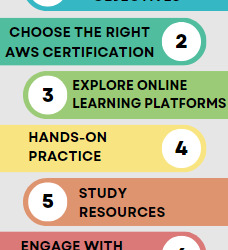
Placement: Unlocking Opportunities
Leveraging AWS Certification in the Job Market
AWS certifications have emerged as a gold standard in the realm of cloud computing. Employers actively seek professionals who possess the skills and credentials to navigate and optimize AWS environments. Discover how an AWS certification can significantly enhance your employability, propel your career trajectory, and open doors to exciting job opportunities in a wide range of industries.
Showcasing your AWS Expertise
Once you have acquired the necessary skills and certifications, it is essential to effectively showcase your AWS expertise. Craft a captivating resume highlighting your AWS experiences and projects. Create a strong online presence through platforms like LinkedIn and GitHub, demonstrating your proficiency to potential employers. Actively participate in AWS forums and communities, exchanging knowledge and insights with fellow professionals and building a robust network.
Continuous Learning and Growth
AWS is a rapidly evolving platform, constantly introducing new services, features, and updates. Stay ahead of the curve by fostering a mindset of continuous learning and growth. Engage in ongoing professional development, attend AWS conferences and webinars, and subscribe to relevant industry publications. By embracing a culture of continuous improvement, you will remain at the forefront of AWS innovation and unlock limitless possibilities for advancement.
Embarking on the journey to mastering AWS Course at ACTE institute can be both exciting and challenging. However, armed with comprehensive education, a well-structured training approach, and a strategic placement strategy, you can level up your cloud skills and unlock a world of opportunities. Start your AWS training today, and transcend the realms of cloud computing like never before!
9 notes
·
View notes
Text
Elevating Your Full-Stack Developer Expertise: Exploring Emerging Skills and Technologies
Introduction: In the dynamic landscape of web development, staying at the forefront requires continuous learning and adaptation. Full-stack developers play a pivotal role in crafting modern web applications, balancing frontend finesse with backend robustness. This guide delves into the evolving skills and technologies that can propel full-stack developers to new heights of expertise and innovation.

Pioneering Progress: Key Skills for Full-Stack Developers
1. Innovating with Microservices Architecture:
Microservices have redefined application development, offering scalability and flexibility in the face of complexity. Mastery of frameworks like Kubernetes and Docker empowers developers to architect, deploy, and manage microservices efficiently. By breaking down monolithic applications into modular components, developers can iterate rapidly and respond to changing requirements with agility.
2. Embracing Serverless Computing:
The advent of serverless architecture has revolutionized infrastructure management, freeing developers from the burdens of server maintenance. Platforms such as AWS Lambda and Azure Functions enable developers to focus solely on code development, driving efficiency and cost-effectiveness. Embrace serverless computing to build scalable, event-driven applications that adapt seamlessly to fluctuating workloads.
3. Crafting Progressive Web Experiences (PWEs):
Progressive Web Apps (PWAs) herald a new era of web development, delivering native app-like experiences within the browser. Harness the power of technologies like Service Workers and Web App Manifests to create PWAs that are fast, reliable, and engaging. With features like offline functionality and push notifications, PWAs blur the lines between web and mobile, captivating users and enhancing engagement.
4. Harnessing GraphQL for Flexible Data Management:
GraphQL has emerged as a versatile alternative to RESTful APIs, offering a unified interface for data fetching and manipulation. Dive into GraphQL's intuitive query language and schema-driven approach to simplify data interactions and optimize performance. With GraphQL, developers can fetch precisely the data they need, minimizing overhead and maximizing efficiency.
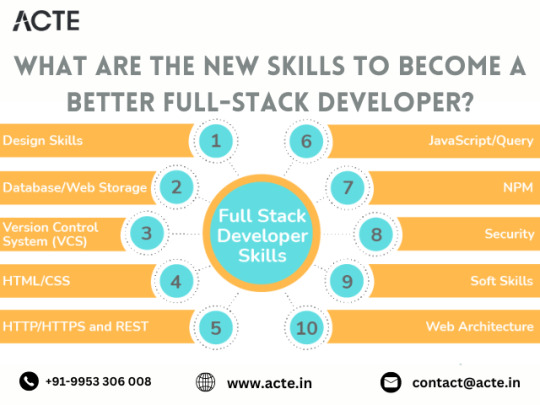
5. Unlocking Potential with Jamstack Development:
Jamstack architecture empowers developers to build fast, secure, and scalable web applications using modern tools and practices. Explore frameworks like Gatsby and Next.js to leverage pre-rendering, serverless functions, and CDN caching. By decoupling frontend presentation from backend logic, Jamstack enables developers to deliver blazing-fast experiences that delight users and drive engagement.
6. Integrating Headless CMS for Content Flexibility:
Headless CMS platforms offer developers unprecedented control over content management, enabling seamless integration with frontend frameworks. Explore platforms like Contentful and Strapi to decouple content creation from presentation, facilitating dynamic and personalized experiences across channels. With headless CMS, developers can iterate quickly and deliver content-driven applications with ease.
7. Optimizing Single Page Applications (SPAs) for Performance:
Single Page Applications (SPAs) provide immersive user experiences but require careful optimization to ensure performance and responsiveness. Implement techniques like lazy loading and server-side rendering to minimize load times and enhance interactivity. By optimizing resource delivery and prioritizing critical content, developers can create SPAs that deliver a seamless and engaging user experience.
8. Infusing Intelligence with Machine Learning and AI:
Machine learning and artificial intelligence open new frontiers for full-stack developers, enabling intelligent features and personalized experiences. Dive into frameworks like TensorFlow.js and PyTorch.js to build recommendation systems, predictive analytics, and natural language processing capabilities. By harnessing the power of machine learning, developers can create smarter, more adaptive applications that anticipate user needs and preferences.
9. Safeguarding Applications with Cybersecurity Best Practices:
As cyber threats continue to evolve, cybersecurity remains a critical concern for developers and organizations alike. Stay informed about common vulnerabilities and adhere to best practices for securing applications and user data. By implementing robust security measures and proactive monitoring, developers can protect against potential threats and safeguard the integrity of their applications.
10. Streamlining Development with CI/CD Pipelines:
Continuous Integration and Deployment (CI/CD) pipelines are essential for accelerating development workflows and ensuring code quality and reliability. Explore tools like Jenkins, CircleCI, and GitLab CI/CD to automate testing, integration, and deployment processes. By embracing CI/CD best practices, developers can deliver updates and features with confidence, driving innovation and agility in their development cycles.
#full stack developer#education#information#full stack web development#front end development#web development#frameworks#technology#backend#full stack developer course
2 notes
·
View notes
Text
AWS Mastery Unveiled: Your Step-by-Step Journey into Cloud Proficiency
In today's rapidly evolving tech landscape, mastering cloud computing is a strategic move for individuals and businesses alike. Amazon Web Services (AWS), as a leading cloud services provider, offers a myriad of tools and services to facilitate scalable and efficient computing. With AWS Training in Hyderabad, professionals can gain the skills and knowledge needed to harness the capabilities of AWS for diverse applications and industries. Whether you're a seasoned IT professional or a beginner eager to dive into the cloud, here's a step-by-step guide to learning and mastering Amazon AWS.
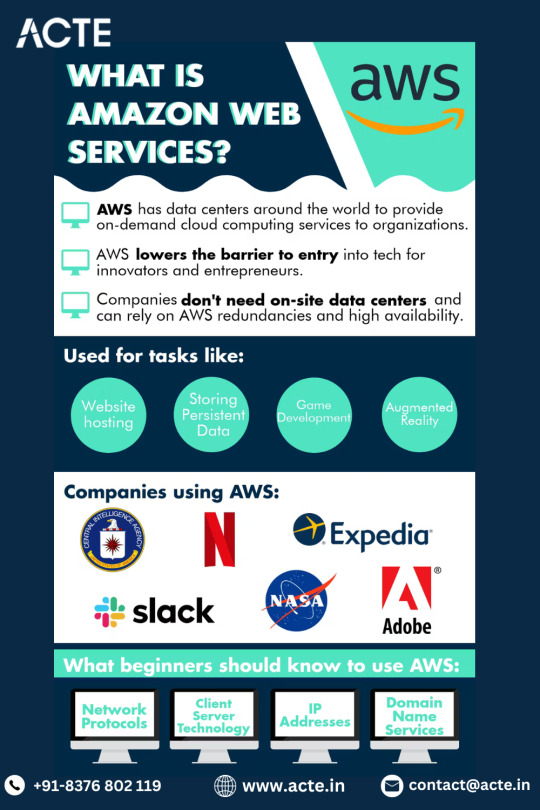
1. Start with AWS Documentation:
The foundation of your AWS journey begins with the official AWS documentation. This vast resource provides detailed information, tutorials, and guides for each AWS service. Take the time to familiarize yourself with the terminologies and fundamental concepts. Understanding the basics lays a solid groundwork for more advanced learning.
2. Enroll in AWS Training and Certification:
AWS provides a dedicated training and certification program to empower individuals with the skills required in today's cloud-centric environment. Explore the AWS Training and Certification portal, which offers a range of courses, both free and paid. Commence your AWS certification journey with the AWS Certified Cloud Practitioner, progressively advancing to specialized certifications aligned with your career goals.
3. Hands-On Practice with AWS Free Tier:
Theory is valuable, but hands-on experience is paramount. AWS Free Tier allows you to experiment with various services without incurring charges. Seize this opportunity to get practical, testing different services and scenarios. This interactive approach reinforces theoretical knowledge and builds your confidence in navigating the AWS console.
4. Explore Online Courses and Tutorials:
Several online platforms offer structured AWS courses. Websites like Coursera, Udemy, and A Cloud Guru provide video lectures, hands-on labs, and real-world projects. These courses cover a spectrum of topics, from foundational AWS concepts to specialized domains like AWS security and machine learning. To master the intricacies of AWS and unlock its full potential, individuals can benefit from enrolling in the Top AWS Training Institute. This training ensures that professionals gain the expertise needed to navigate the complexities of AWS, empowering them to contribute effectively to their organizations' digital transformation and success.
5. Build Projects and Apply Knowledge:
The true test of your AWS proficiency lies in applying your knowledge to real-world projects. Start small, perhaps by deploying a static website on Amazon S3. As you gain confidence, move on to more complex projects, such as configuring a virtual server on Amazon EC2 or creating a serverless application using AWS Lambda. Practical application solidifies your understanding and hones your problem-solving skills.
6. Join AWS Communities and Forums:
Learning is a collaborative effort. Joining AWS communities and forums allows you to connect with like-minded individuals, seek advice, and share your experiences. Platforms like the AWS Developer Forums provide a space for discussing challenges and learning from others' insights. Networking within the AWS community can open doors to valuable opportunities and collaborations.
7. Read AWS Whitepapers and Case Studies:
AWS regularly publishes whitepapers covering best practices, architecture recommendations, and real-world case studies. Delve into these resources to gain deeper insights into how AWS services are applied in diverse scenarios. Whitepapers provide a wealth of knowledge on topics such as security, scalability, and cost optimization.
8. Experiment with AWS CLI and SDKs:
Command Line Interface (CLI) proficiency is a valuable skill for any AWS practitioner. Familiarize yourself with the AWS CLI, as well as Software Development Kits (SDKs) for your preferred programming languages. Automating tasks through the CLI and integrating AWS services into your applications enhances efficiency and allows for more sophisticated configurations.
9. Attend AWS Events and Webinars:
Stay abreast of the latest AWS trends, updates, and best practices by attending AWS events, webinars, and conferences. These platforms often feature expert speakers, product announcements, and in-depth discussions on specific AWS topics. Engaging with industry leaders and experts provides valuable insights into the current state and future direction of AWS.
10. Stay Updated and Adapt:
The cloud computing landscape is dynamic, with AWS continually introducing new services and updates. Subscribe to AWS newsletters, follow AWS blogs, and listen to AWS-focused podcasts to stay informed about the latest developments. Continuous learning is key to adapting to the evolving cloud technology landscape.
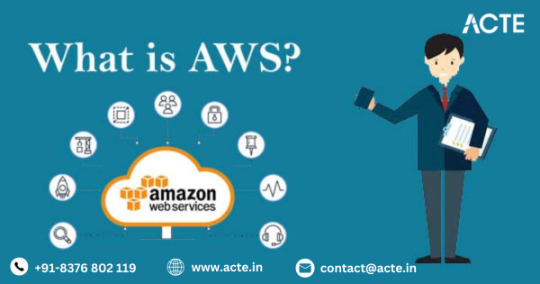
In conclusion, mastering Amazon AWS is a journey that combines theoretical understanding, hands-on experience, and active participation in the AWS community. By following these ten steps, you can develop a comprehensive skill set that empowers you to leverage AWS effectively, whether you're building applications, optimizing processes, or advancing your career in the cloud.
2 notes
·
View notes
Text
Advanced Techniques in Full-Stack Development

Certainly, let's delve deeper into more advanced techniques and concepts in full-stack development:
1. Server-Side Rendering (SSR) and Static Site Generation (SSG):
SSR: Rendering web pages on the server side to improve performance and SEO by delivering fully rendered pages to the client.
SSG: Generating static HTML files at build time, enhancing speed, and reducing the server load.
2. WebAssembly:
WebAssembly (Wasm): A binary instruction format for a stack-based virtual machine. It allows high-performance execution of code on web browsers, enabling languages like C, C++, and Rust to run in web applications.
3. Progressive Web Apps (PWAs) Enhancements:
Background Sync: Allowing PWAs to sync data in the background even when the app is closed.
Web Push Notifications: Implementing push notifications to engage users even when they are not actively using the application.
4. State Management:
Redux and MobX: Advanced state management libraries in React applications for managing complex application states efficiently.
Reactive Programming: Utilizing RxJS or other reactive programming libraries to handle asynchronous data streams and events in real-time applications.
5. WebSockets and WebRTC:
WebSockets: Enabling real-time, bidirectional communication between clients and servers for applications requiring constant data updates.
WebRTC: Facilitating real-time communication, such as video chat, directly between web browsers without the need for plugins or additional software.
6. Caching Strategies:
Content Delivery Networks (CDN): Leveraging CDNs to cache and distribute content globally, improving website loading speeds for users worldwide.
Service Workers: Using service workers to cache assets and data, providing offline access and improving performance for returning visitors.
7. GraphQL Subscriptions:
GraphQL Subscriptions: Enabling real-time updates in GraphQL APIs by allowing clients to subscribe to specific events and receive push notifications when data changes.
8. Authentication and Authorization:
OAuth 2.0 and OpenID Connect: Implementing secure authentication and authorization protocols for user login and access control.
JSON Web Tokens (JWT): Utilizing JWTs to securely transmit information between parties, ensuring data integrity and authenticity.
9. Content Management Systems (CMS) Integration:
Headless CMS: Integrating headless CMS like Contentful or Strapi, allowing content creators to manage content independently from the application's front end.
10. Automated Performance Optimization:
Lighthouse and Web Vitals: Utilizing tools like Lighthouse and Google's Web Vitals to measure and optimize web performance, focusing on key user-centric metrics like loading speed and interactivity.
11. Machine Learning and AI Integration:
TensorFlow.js and ONNX.js: Integrating machine learning models directly into web applications for tasks like image recognition, language processing, and recommendation systems.
12. Cross-Platform Development with Electron:
Electron: Building cross-platform desktop applications using web technologies (HTML, CSS, JavaScript), allowing developers to create desktop apps for Windows, macOS, and Linux.
13. Advanced Database Techniques:
Database Sharding: Implementing database sharding techniques to distribute large databases across multiple servers, improving scalability and performance.
Full-Text Search and Indexing: Implementing full-text search capabilities and optimized indexing for efficient searching and data retrieval.
14. Chaos Engineering:
Chaos Engineering: Introducing controlled experiments to identify weaknesses and potential failures in the system, ensuring the application's resilience and reliability.
15. Serverless Architectures with AWS Lambda or Azure Functions:
Serverless Architectures: Building applications as a collection of small, single-purpose functions that run in a serverless environment, providing automatic scaling and cost efficiency.
16. Data Pipelines and ETL (Extract, Transform, Load) Processes:
Data Pipelines: Creating automated data pipelines for processing and transforming large volumes of data, integrating various data sources and ensuring data consistency.
17. Responsive Design and Accessibility:
Responsive Design: Implementing advanced responsive design techniques for seamless user experiences across a variety of devices and screen sizes.
Accessibility: Ensuring web applications are accessible to all users, including those with disabilities, by following WCAG guidelines and ARIA practices.
full stack development training in Pune
2 notes
·
View notes
Text
Exploring AWS Lambda: Use Cases, Security, Performance Tips, and Cost Management

AWS Lambda, a core component of serverless architecture, empowers developers, cloud architects, data engineers, and business decision-makers by allowing code execution in response to specific events without managing servers. This flexibility is ideal for many modern applications but requires a nuanced understanding of its use cases, security considerations, performance factors, and cost implications to maximize its benefits.
In the first part, ‘exploring AWS lambda – a guide to serverless use cases,’ we saw how AWS Lambda enables efficient and scalable real-time data processing, facilitates backend services automation, supports microservices architecture, and enhances IoT applications by processing sensor data. It highlighted use cases like image processing, real-time notifications, and on-the-fly data transformations, emphasizing Lambda’s role in creating responsive, cost-effective applications without server management overhead.
Why it is important to understand AWS Lambda
Knowing when to use or avoid AWS Lambda is crucial for optimizing performance and cost. Our team of AWS experts emphasizes this while providing AWS consulting. For developers and cloud architects, this understanding leads to efficient resource allocation and streamlined workflows. Data engineers benefit from leveraging Lambda’s capabilities for real-time data processing, while business decision-makers can make informed choices about infrastructure investments, ensuring cost-effective and scalable solutions.
Statistics from AWS reveal a compelling fact: Companies leveraging Lambda for event-driven applications experience up to a staggering 70% reduction in operational costs. This potential for significant cost savings should motivate businesses to delve deeper into Lambda. Understanding its security implications can protect sensitive data, and optimizing performance ensures a seamless user experience. However, misuse or misunderstanding of Lambda can lead to increased costs, security vulnerabilities, and performance bottlenecks. This underscores the importance of gaining a comprehensive understanding of Lambda.
Where to use AWS Lambda
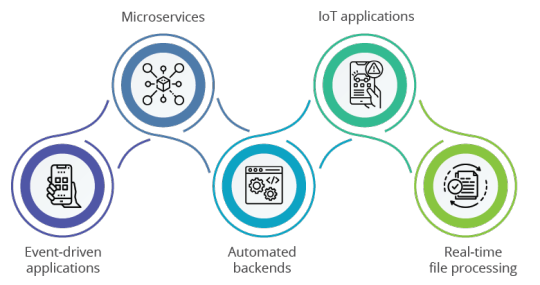
Event-driven applications: AWS Lambda shines in event-driven scenarios. Imagine an e-commerce platform that processes and verifies customer orders. Lambda can trigger functions upon order placement, ensuring swift and reliable processing. This event-driven model streamlines operations and reduces latency. For developers, this means faster deployment and reduced overhead.
Microservices: Lambda’s modular nature makes it a perfect fit for microservices architecture. Each function can be developed, deployed, and scaled independently. For example, a social media platform can use Lambda to handle user notifications, where each type of notification is a separate microservice, allowing for isolated management and scaling. Cloud architects will find this helpful in designing scalable and maintainable systems.
Automated backends: For tasks like user authentication, data validation, or generating reports, Lambda offers an automated, scalable backend solution. This is particularly effective for applications with sporadic workloads, as Lambda only runs when needed, saving costs on idle server time. Business decision-makers benefit from cost efficiency and flexibility.
IoT applications: In IoT ecosystems, Lambda can process data from connected devices in real-time. For instance, a smart home system might use Lambda to analyze sensor data and trigger actions such as adjusting the thermostat or sending alerts, ensuring responsive and efficient device management. Data engineers can leverage Lambda for seamless data processing and integration.
Real-time file processing: Lambda is excellent for real-time file processing. Consider a photo-sharing application where users upload images. Lambda functions can automatically resize images and store them in various formats in an S3 bucket, ensuring a seamless user experience.
Suggested: Apart from when to use Lambda, do you want to know more about why successful businesses are cloud-based? Read this!
Where not to use AWS Lambda

Long-running processes: Lambda functions have a maximum execution time of 15 minutes. For applications requiring longer processing times, like video rendering or extensive data analysis, traditional EC2 instances or ECS services are more suitable.
High-performance computing: Tasks requiring significant computational power, such as complex simulations or machine learning model training, may need to improve on Lambda due to its limited resource allocation compared to dedicated HPC solutions. Developers working on resource-intensive applications should consider more powerful options.
Steady load applications: For applications with a predictable, continuous load, such as streaming services, maintaining dedicated servers or using containerized environments can be more cost-effective. Lambda’s pay-per-request model may lead to higher costs for sustained high-volume traffic.
Complex state management: Applications requiring persistent connections or complex state management, such as multiplayer online games or real-time chat applications, may face challenges with Lambda. Maintaining a state across stateless function invocations can take time and effort. Cloud architects should consider traditional server setups for such use cases.
Security implications of AWS Lambda
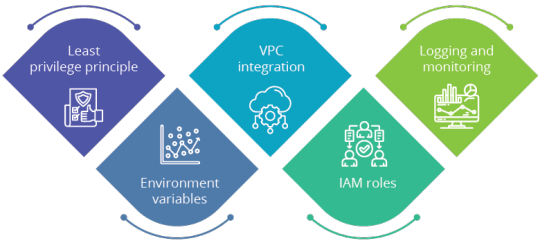
Least privilege principle: Lambda functions should follow the principle of least privilege, ensuring they have only the necessary permissions to perform their tasks. This minimizes the risk of unauthorized access and potential security breaches. Cloud architects must ensure strict access controls and permission settings.
Environment variables: Avoid storing sensitive data like API keys or credentials in environment variables. Instead, utilize AWS Secrets Manager or AWS Systems Manager Parameter Store for secure storage and retrieval of sensitive information. Developers should follow best practices for handling confidential information.
VPC integration: Running Lambda functions within a Virtual Private Cloud (VPC) can enhance security by restricting network access to AWS resources. This isolates Lambda functions from the public internet, reducing exposure to potential attacks. Security-conscious architects can leverage VPC integration for additional protection.
IAM roles: Properly configured IAM roles and policies are crucial for Lambda functions. Assigning specific roles to functions ensures they can access only the resources they need, reducing the risk of privilege escalation.
Logging and monitoring: Enabling logging with AWS CloudWatch allows for real-time monitoring of Lambda function activity. Setting up alerts for unusual behavior helps promptly detect and respond to security incidents.
Suggested: Check out the ultimate guide to application integration on AWS!
Performance and cost impact of using AWS Lambda
Performance

Cold starts: Cold starts occur when a Lambda function is invoked after inactivity, leading to initialization latency. While this can impact performance, using Provisioned Concurrency can keep functions warm, reducing latency for critical functions. Developers should be aware of this to ensure responsive applications.
Resource allocation: Optimizing memory and timeout settings can significantly enhance performance. Allocating adequate memory ensures functions execute efficiently, reducing execution time and improving user experience.
Concurrency limits: Managing concurrency limits is essential to avoid throttling issues. By monitoring CloudWatch metrics, you can adjust concurrency settings to ensure smooth operation during peak times. Cloud architects need to manage these settings to maintain application reliability.
Cost

Pay-per-use model: Lambda’s pricing is based on the number of requests and the duration of code execution. This model is cost-effective for applications with sporadic usage patterns, as you only pay for actual compute time. Business decision-makers will appreciate the cost savings and scalability.
Free tier: AWS offers a generous free tier for Lambda, including 1 million free requests and 400,000 GB-seconds of compute time per month. This makes it an attractive option for startups and small-scale applications.
Cost management: Regularly reviewing usage and optimizing function performance can help avoid unnecessary costs. Implementing cost monitoring and alerts through AWS Cost Explorer or similar tools ensures you stay within budget.
Also read: How can you maximize savings by avoiding five common mistakes that increase your AWS bill?
Identifying performance issues in AWS Lambda

Cold start latency: Analyze logs to identify high latencies due to cold starts. Provisioned concurrency can mitigate these delays by pre-warming functions. Developers should monitor these metrics to enhance user experience.
Timeout errors: Monitoring for timeout errors indicates whether functions need more execution time or optimization. Adjusting timeout settings or refining code can resolve these issues. Cloud architects should ensure functions are correctly tuned to avoid disruptions.
Throttling: Throttling events, visible in CloudWatch metrics, indicate that the concurrency limit has been reached. Adjusting concurrency settings or optimizing function performance can help prevent throttling. Business decision-makers should consider these metrics when planning for scalability.
Memory usage: Evaluating memory usage metrics ensures functions are adequately provisioned. Under-provisioned functions can suffer from performance issues, while over-provisioning can lead to unnecessary costs. Data engineers should optimize memory settings for efficient data processing.
Execution duration: Optimizing code to reduce execution time improves performance and controls costs. Efficient code execution minimizes the time functions run, leading to cost savings.
Summary
By understanding where to use and where not to use Lambda, security practices, performance considerations, and cost implications of Lambda, organizations can effectively leverage serverless computing to build scalable, efficient, and secure applications. Here’s a summarized view:
Aspect: Where to use Lambda
Recommendations: Event-driven apps, microservices, automated backends, IoT and real-time file processing.
Aspect: Where not to use Lambda
Recommendations: Long-running processes, high-performance computing, steady load apps and complex state management.
Aspect: Security implications
Recommendations: Least privilege, secure environment variables, VPC integration, IAM roles and logging
Aspect: Performance considerations
Recommendations: Mitigate cold starts, optimize resource allocation and manage concurrency limits.
Aspect: Cost impacts
Recommendations: Utilize pay-per-use, leverage free tier, regular cost review and optimization
This comprehensive understanding ensures that you can maximize the benefits of AWS Lambda while mitigating potential drawbacks, leading to robust and cost-effective applications.
Originally published at https://www.softwebsolutions.com on June 25, 2024.
1 note
·
View note
Text
Yes, I Got a Cloud Server for Free Forever Here’s How You Can Too.
Let me tell you a little secret: I'm running a cloud server right now—for zero dollars. No tricks, no expired trials, no surprise bills. Just forever free. And the best part? You can do it too.
This isn’t one of those “free for 12 months” offers that quietly auto-bills you after a year. This is 100% free forever, and I’ve been using it to host websites, run experiments, and even power a personal VPN.
Here's how I did it—and how you can get your own cloud server for free too.

🧠 First, Why Would You Even Want a Cloud Server? If you’re a dev, student, entrepreneur, or just someone who wants to mess around with tech, a cloud server is basically your Swiss Army knife. You can:
Host your own blog or portfolio
Deploy web apps
Run bots or automation scripts
Set up a secure VPN
Tinker with Docker, Node.js, Python, and other cool tools
Learn cloud infrastructure (and impress your next job interviewer)
But traditionally, cloud servers cost money. Not a lot—but still enough to be annoying if you’re bootstrapping.
🧨 The Hack: Free-Tier Cloud Servers (Yes, They’re Legit) Here’s the part most people don’t realize: some major cloud providers offer "always free" tiers. These aren’t trials. They’re permanent free resources designed to bring developers into their ecosystem.
Let me break down the best ones:
🟢 Oracle Cloud - The Real MVP What You Get (Always Free):
2 Arm-based virtual machines (VMs)
1 GB RAM each, up to 4 vCPUs
200 GB storage
10 TB/month of data transfer
👉 This is what I'm using. It’s not just a toy—this thing can run websites, apps, and even a Minecraft server (with some optimization). It’s shockingly good for something that costs nothing.
Pro Tip: Choose the Ampere A1 (Arm) VM when signing up. They're the magic machines that stay free forever.
🔵 Google Cloud Free Tier 1 f1-micro VM (in select regions)
30 GB HDD + 5 GB snapshot storage
1 GB outbound traffic
It’s more limited, but solid if you want to dip your toes into Google’s ecosystem. Great for small side projects or learning.
🟠 Amazon AWS Free Tier 750 hours/month of a t2.micro or t3.micro EC2 instance
5 GB S3 storage
Other bonuses like Lambda and DynamoDB
⚠️ This one’s only free for the first 12 months, so set a calendar reminder unless you want to wake up to a surprise bill.
Honorable Mentions (For Web Devs & Hobby Projects) Flyio – Run full-stack apps with generous free bandwidth
Render / Railway – Deploy static sites, APIs, and databases with ease
GitHub Student Pack – If you’re a student, you unlock a TON of free cloud goodies
⚠️ A Few Quick Warnings Before you go server-crazy:
Stick to free-tier specs (e.g. Oracle’s Ampere A1, Google’s f1-micro)
Watch bandwidth usage—10 TB sounds like a lot, until it isn’t
Avoid regions that aren’t free (yes, it matters where your VM is located)
Set up billing alerts or hard limits if the provider allows it
So… What Can You Actually Do With a Free Server? Here’s what I use mine for:
✅ Hosting my personal website (no ads, no downtime) ✅ Running a WireGuard VPN to stay safe on public Wi-Fi ✅ Testing code 24/7 without killing my laptop ✅ Hosting bots for Discord and Telegram ✅ Learning Linux, Docker, and server security
Basically, it’s my own little lab in the cloud—and I didn’t pay a dime for it.
Final Thoughts: Cloud Power in Your Pocket (For Free) In a world where subscriptions are everywhere and everything feels like a money grab, it's refreshing to find real value that doesn’t cost you anything. These cloud free tiers are hidden gems—quietly sitting there while most people assume you need a credit card and a corporate budget to get started.
So go ahead. Spin up your own free cloud server. Learn. Build. Break things. And have fun doing it—on someone else’s infrastructure.
🔗 Want to try it?
Oracle Cloud Free Tier
Google Cloud Free Tier
AWS Free Tier
1 note
·
View note
Text
The Future of Web Development: Trends and Strategies for 2024
Introduction
In today’s digital age, web development is more crucial than ever. Businesses like City Insider Inc rely on cutting-edge websites to engage users, drive sales, and establish a strong online presence. With rapid advancements in technology, staying updated on the latest trends in web development is essential for creating fast, secure, and user-friendly websites. This article explores the top trends, tools, and best practices shaping the future of web development in 2024.
1. The Rise of AI and Machine Learning in Web Development
Artificial Intelligence (AI) and Machine Learning (ML) are revolutionizing web development. From chatbots that enhance customer service to personalized content recommendations, AI-powered tools are making websites smarter. Platforms like City Insider Inc can leverage AI to analyze user behavior, optimize SEO, and automate repetitive tasks. Tools such as TensorFlow.js and OpenAI integrations allow developers to build dynamic, intelligent web applications with ease.
2. Progressive Web Apps (PWAs) for Enhanced Performance
Progressive Web Apps (PWAs) combine the best of websites and mobile apps, offering offline functionality, push notifications, and fast loading speeds. For businesses like City Insider Inc, PWAs provide a seamless user experience across all devices. Companies like Twitter and Pinterest have already seen significant engagement boosts by adopting PWAs. With frameworks like React and Angular, developers can build high-performing PWAs that improve retention and conversions.
3. Voice Search Optimization and Voice-Activated Interfaces
With the growing popularity of smart speakers like Alexa and Google Home, voice search optimization is becoming a key focus in web development. Websites must now be structured to answer voice queries naturally. City Insider Inc can stay ahead by implementing schema markup and optimizing for long-tail keywords. Additionally, integrating voice-activated navigation into websites enhances accessibility and user experience, making it a must-have feature in 2024.
4. Motion UI and Interactive Design Elements
Engaging visuals and micro-interactions are dominating modern web development. Motion UI—such as animated buttons, scroll-triggered effects, and 3D graphics—creates immersive experiences. Tools like Framer Motion and GSAP help developers implement smooth animations without compromising performance. For City Insider Inc, incorporating interactive design elements can increase user engagement and reduce bounce rates.
5. Cybersecurity and Privacy-First Development
As cyber threats increase, prioritizing security in web development is non-negotiable. GDPR compliance, HTTPS encryption, and regular vulnerability assessments are essential. Businesses like City Insider Inc must ensure secure payment gateways and data protection measures to build trust with users. Frameworks like OWASP provide guidelines for developing hack-resistant websites, making security a top priority in 2024.
6. Serverless Architecture for Scalability
Serverless computing allows developers to build and deploy applications without managing servers, reducing costs and improving scalability. Platforms like AWS Lambda and Firebase enable City Insider Inc to handle traffic spikes efficiently. Serverless architecture also enhances performance by minimizing backend latency, making it ideal for dynamic web applications.
7. Low-Code and No-Code Development Platforms
Not everyone needs deep coding knowledge to build a website anymore. Low-code and no-code platforms like Webflow and Bubble empower businesses to create functional sites quickly. While professional web development still requires custom solutions, these tools allow City Insider Inc to prototype ideas and launch MVPs faster than ever before.
8. The Growing Importance of Core Web Vitals
Google’s Core Web Vitals (loading speed, interactivity, and visual stability) directly impact SEO rankings. Optimizing these metrics ensures a smooth user experience. City Insider Inc can leverage tools like Lighthouse and PageSpeed Insights to audit and enhance website performance. Faster load times and responsive designs lead to higher conversions and better search visibility.
Conclusion
The future of web development is dynamic, driven by AI, PWAs, voice search, and enhanced security. For businesses like City Insider Inc, adopting these trends ensures a competitive edge in the digital landscape. By focusing on user experience, performance, and innovation, companies can build websites that captivate audiences and drive growth in 2024 and beyond.
Stay ahead with cutting-edge web development strategies—partner with experts to transform your online presence today!
0 notes
Text
Unlocking Agile Operations with the Power of Information Cloud

Introduction
In today’s rapidly changing digital landscape, agility is more than a competitive edge—it’s a business necessity. Organizations must be able to respond quickly to market demands, customer needs, and operational disruptions. This is where the Information Cloud comes in, serving as a dynamic foundation for enabling agile operations across all business functions.
The Information Cloud refers to an integrated, cloud-native environment that centralizes data, applications, and services to support fast, flexible, and scalable decision-making. Whether in manufacturing, logistics, finance, or customer service, an Information Cloud empowers teams with real-time insights, collaboration tools, and data-driven automation—transforming rigid processes into responsive, intelligent workflows.
What Is an Information Cloud?
An Information Cloud is a cloud-based infrastructure that brings together data storage, analytics, and communication platforms under one secure, accessible ecosystem. It supports:
Unified data access across departments
Real-time analytics and reporting
Scalable storage and compute power
Seamless integration with business applications
Intelligent automation and AI-driven decisions
Popular platforms enabling this capability include Microsoft Azure, AWS, Google Cloud, and hybrid solutions that blend private and public cloud environments.
Key Benefits of an Information Cloud for Agile Operations:
Real-Time Decision-Making Access to up-to-the-minute data enables faster, more informed decisions, especially during critical business events or disruptions.
Cross-Team Collaboration Cloud-based collaboration tools and shared data platforms help teams work in sync, regardless of location or department.
Operational Flexibility Agile workflows powered by cloud data ensure your business can pivot quickly—adapting to new demands without the need for infrastructure changes.
Cost Efficiency and Scalability Pay-as-you-go models and elastic scaling ensure you only use the resources you need, reducing operational overhead.
Business Continuity and Resilience Cloud-based backups, failovers, and remote access protect operations from on-premise system failures or disasters.
How to Build an Agile Operation with Information Cloud:
Centralize Data Repositories Unify siloed data sources into cloud platforms like Azure Data Lake, AWS S3, or Google BigQuery.
Adopt Cloud-Native Tools Leverage platforms like Power BI, Tableau, or Looker for real-time dashboards and analytics.
Automate Workflows Use services like Azure Logic Apps, AWS Lambda, or ServiceNow for intelligent process automation.
Enable Self-Service Analytics Empower employees with no-code/low-code tools to build their own reports and automate tasks.
Ensure Governance and Security Use built-in cloud controls to maintain compliance, monitor access, and enforce data privacy.
Real-World Use Cases:
Supply Chain Agility: Real-time tracking and predictive analytics enable proactive inventory management and logistics.
Finance and Accounting: Automated reporting and forecasting tools ensure quick insights into cash flow and profitability.
Healthcare Operations: Unified patient records and predictive care management enhance service delivery.
Smart Manufacturing: IoT sensors and cloud analytics optimize production schedules and machine maintenance.
Best Practices:
Start small with one or two cloud-enabled processes before scaling.
Regularly review data governance policies for security and compliance.
Train staff on cloud collaboration tools and agile methodologies.
Continuously monitor performance using integrated dashboards.
Conclusion:
An Information Cloud is more than just storage—it's the digital nervous system of an agile enterprise. By centralizing data, empowering teams with intelligent tools, and fostering cross-functional collaboration, it enables businesses to move faster, respond smarter, and operate more efficiently. Whether you're building smart factories, modernizing back-office functions, or enhancing customer experiences, the Information Cloud equips your organization to lead with agility in a digital-first world.
0 notes
Text
Full Stack Development Trends in 2025: What to Expect
In the rapidly evolving tech landscape, full stack development continues to be a crucial area for innovation and career growth. As we step into 2025, the demand for skilled professionals who can handle both front-end and back-end technologies is only expected to surge. From artificial intelligence integration to serverless architectures, this field is experiencing some major transformations.
Whether you're a student, a working professional, or someone planning to switch careers, understanding these full stack development trends is essential. And if you're planning to learn full stack development in Pune, one of India’s tech hubs, staying updated with these trends will give you a competitive edge.
Why Full Stack Development Matters More Than Ever
Modern businesses seek agility and efficiency in software development. Full stack developers can handle various layers of a web or app project—from UI/UX to database management and server logic. This ability to operate across multiple domains makes full stack professionals highly valuable.
Here’s what’s changing in 2025 and why it matters:
Key Full Stack Development Trends to Watch in 2025
1. AI and Machine Learning-Driven Development
Integration of AI for predictive user experiences
Chatbots and intelligent systems as part of app architecture
Developers using AI tools to assist with debugging, code generation, and optimization
With these technologies becoming more accessible, full stack developers are expected to understand how AI models work and how to implement them efficiently.
2. Serverless Architectures on the Rise
Reduction in infrastructure management tasks
Focus shifts to writing quality code without worrying about deployment
Increased use of platforms like AWS Lambda, Azure Functions, and Google Cloud Functions
Serverless frameworks will empower developers to build scalable applications faster, and those enrolled in a Java programming course with placement are already being introduced to these platforms as part of their curriculum.
3. Micro Frontends and Component-Based Architectures
Projects are being split into smaller, manageable front-end components
Encourages reuse and parallel development
Helps large teams work on different parts of an application efficiently
This trend is changing the way teams collaborate, especially in agile environments.
4. Progressive Web Applications (PWAs) Becoming the Norm
PWAs offer app-like experiences in browsers
Offline support, push notifications, and fast load times
Ideal for startups and enterprises alike
A full stack developer in 2025 must be proficient in building PWAs using modern tools like React, Angular, and Vue.js.
5. API-First Development
Focus on creating flexible, scalable backend systems
REST and GraphQL APIs powering multiple frontends (web, mobile, IoT)
Encourages modular architecture
Many courses teaching full stack development in Pune are already emphasizing this model to prepare students for real-world industry demands.
6. Focus on Security and Compliance
Developers now need to consider security during initial coding phases
Emphasis on secure coding practices, data privacy, and GDPR compliance
DevSecOps becoming a standard practice
7. DevOps and Automation
CI/CD pipelines becoming essential in full stack workflows
Containerization using Docker and Kubernetes is standard
Developers expected to collaborate closely with DevOps engineers
8. Real-Time Applications with WebSockets and Beyond
Messaging apps, live dashboards, and real-time collaboration tools are in demand
Tools like Socket.IO and WebRTC are becoming essential in the developer toolkit
Skills That Will Define the Future Full Stack Developer
To thrive in 2025, here are the skills you need to master:
Strong foundation in JavaScript, HTML, CSS
Backend frameworks like Node.js, Django, or Spring Boot
Proficiency in databases – both SQL and NoSQL
Familiarity with Java programming, especially if pursuing a Java programming course with placement
Understanding of cloud platforms like AWS, GCP, or Azure
Working knowledge of version control (Git), CI/CD, and Docker
Why Pune is the Ideal Place to Start Your Full Stack Journey
If you're serious about making a career in this domain, it's a smart move to learn full stack development in Pune. Here's why:
Pune is home to hundreds of tech companies and startups, offering abundant internship and placement opportunities
Numerous training institutes offer industry-aligned courses, often bundled with certifications and placement assistance
Exposure to real-world projects through bootcamps, hackathons, and meetups
Several programs in Pune combine full stack development training with a Java programming course with placement, ensuring you gain both frontend/backend expertise and a strong OOP (Object-Oriented Programming) base.
Final Thoughts
The field of full stack development is transforming, and 2025 is expected to bring more intelligent, scalable, and modular application ecosystems. Whether you’re planning to switch careers or enhance your current skill set, staying updated with the latest full stack development trends will be essential to succeed.
Pune’s tech ecosystem makes it an excellent place to start. Enroll in a trusted institute that offers you a hands-on experience and includes in-demand topics like Java, serverless computing, DevOps, and microservices.
To sum up:
2025 Full Stack Development Key Highlights:
AI integration and smart development tools
Serverless and micro-frontend architectures
Real-time and API-first applications
Greater focus on security and cloud-native environments
Now is the time to upskill, get certified, and stay ahead of the curve. Whether you learn full stack development in Pune or pursue a Java programming course with placement, the tech world of 2025 is full of opportunities for those prepared to seize them.
0 notes
Text
AWS Unveiled: Exploring the Boundless Horizons of Cloud Computing
Introduction: Embarking on the AWS Expedition
In the ever-evolving digital sphere, Amazon Web Services (AWS) emerges as a formidable player, revolutionizing the landscape of cloud computing and redefining the way businesses operate in the digital era. Offering an extensive array of cloud services, AWS serves as a catalyst for innovation, empowering organizations to scale, adapt, and thrive in a rapidly changing environment. Let's embark on an expedition into the realm of AWS, unraveling its diverse offerings and uncovering the transformative potential it holds for businesses across industries.

Decoding AWS: A Gateway to Digital Transformation
Amazon Web Services, or AWS, represents a comprehensive suite of cloud computing solutions provided by Amazon. Designed to meet the diverse needs of businesses, AWS offers a plethora of services spanning compute, storage, databases, machine learning, and more. By leveraging the power of the cloud, organizations can access scalable, flexible, and cost-effective solutions without the burden of managing physical infrastructure.
Exploring the Versatility of AWS: A Closer Look at Key Benefits
Unmatched Scalability: At the heart of AWS lies its unparalleled scalability, enabling businesses to seamlessly adjust their infrastructure to accommodate fluctuating demands. Whether faced with rapid growth or sudden spikes in traffic, AWS empowers organizations to scale their resources dynamically, ensuring optimal performance and resource utilization.
Cost-Efficient Operations: AWS adopts a pay-as-you-go pricing model, eliminating the need for upfront investments in infrastructure. By paying only for the resources they consume, organizations can optimize costs, improve budgetary predictability, and allocate resources more efficiently, thereby driving significant cost savings over time.
Global Accessibility: With a global network of data centers spanning multiple regions, AWS offers businesses unparalleled accessibility to cloud services from anywhere in the world. This global infrastructure enables organizations to deploy applications closer to their end-users, reducing latency, and enhancing the overall user experience.
Robust Security Measures: Security is paramount in the digital age, and AWS prioritizes data protection through robust encryption, identity management, and compliance certifications. By adhering to stringent security standards, AWS ensures the confidentiality, integrity, and availability of data, instilling confidence in businesses and customers alike.
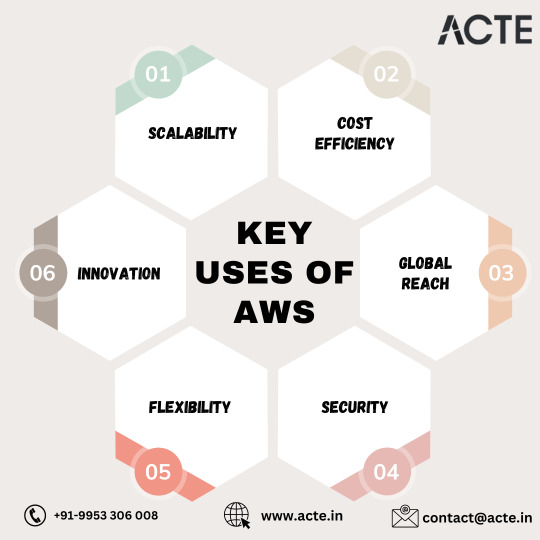
Tailored Solutions for Every Need: AWS provides businesses with a diverse portfolio of services and tools, allowing them to customize their cloud environment to suit their specific requirements. Whether it's compute, storage, analytics, or machine learning, AWS offers a comprehensive suite of solutions tailored to address the unique needs of every organization.
Driving Innovation and Agility: AWS fuels innovation by granting access to cutting-edge technologies such as artificial intelligence, machine learning, and IoT. Through services like AWS Lambda and Amazon SageMaker, organizations can experiment, iterate, and innovate at an accelerated pace, gaining a competitive edge in the market and driving digital transformation.
Conclusion: Embracing the AWS Advantage for Future Growth
In conclusion, Amazon Web Services (AWS) represents a gateway to limitless possibilities, offering businesses the tools, resources, and agility they need to thrive in the digital age. By harnessing the power of AWS, organizations can unlock new opportunities, drive innovation, and achieve unparalleled scalability and efficiency in their operations. Whether you're a startup striving for rapid growth or an enterprise seeking to optimize costs, AWS provides the foundation for success in today's dynamic business landscape. So, seize the moment, embrace the AWS advantage, and embark on a journey of endless growth and innovation.
2 notes
·
View notes